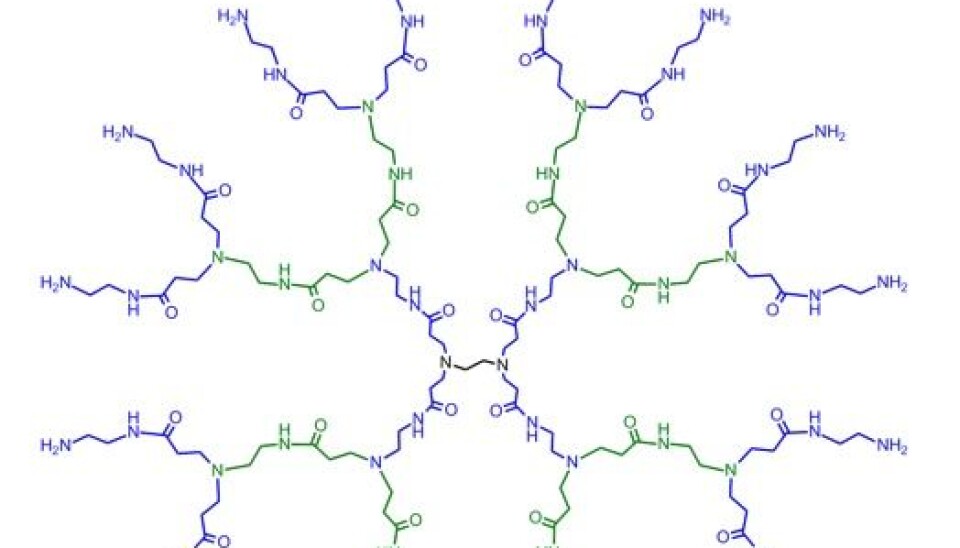
Synthetic supermolecule to fight cancer, arthritis and herpes
They look like tiny trees and they can be used to produce everything from printer ink to cancer drugs. New book outlines the great therapeutic potential of the supermolecules known as dendrimers.
Although you may never have heard of dendrimers, you’re likely to have come across these little molecules in one way or another.
They can be found in some types of shampoo, cosmetics, dental fillings, printer cartridges and many other materials that we’re in contact with every day.
And it appears that we can expect to encounter even more of these dendrimers. This is because in the future, these special molecules will play a part in the treatment of diseases such as cancer, arthritis and herpes, says Jørn Bolstad Christensen, an associate professor at Copenhagen University’s Department of Chemistry.
“What’s really clever about detrimers is that we can design the molecules almost entirely as we wish. This means that we can use them for lots of different purposes.”

Christensen has co-authored a new book about the special dendrimer molecules, which has just been published by Cambridge University Press.
A miniature tree
So what kind of molecule is a dendrimer? According to Christensen, a dendrimer can be composed of a range of different substances. The molecule’s secret is that it has a highly special structure. If you look at it in a microscope, it looks like a little tree with a large crown which splits into branches.
“If you think of an oak tree complete with roots and a crown, then you have the basic structure of a dendrimer,” he explains.
This kind of branched structure can normally only be found in natural, organic molecules – that is molecules that originate from living beings.
What’s really clever about detrimers is that we can design the molecules almost entirely as we wish. This means that we can use them for lots of different purposes.
“The dendrimers are created artificially, but their structure enables scientists to mimic the substances found in nature.”
These synthetic molecules can for instance mimic the properties in natural substances such as hair, wood, mother of pearl and bone.
“This makes them incredibly interesting for a lot of industrial and scientific applications, precisely because they bridge the gap between the chemical and the biological.”
From shampoo to dental fillings
As early as in the 1950s it was predicted that it would be possible to artificially create molecules that resembled nature’s own molecules and use them to create new materials. It wasn’t until the late 1970s that a German researcher became the first scientist to create a dendrimer. Since then, countless researchers and businesses have been working with these molecules, and today there are thousands of scientific articles and patents on dendrimers.
The dendrimers are created artificially, but their structure enables scientists to mimic the substances found in nature. This makes them incredibly interesting for a lot of industrial and scientific applications, precisely because they bridge the gap between the chemical and the biological.
”When I started working on the book, I checked which companies had a patent on dendrimers,” says Christensen. “I was surprised to see how many different types of companies actually use dendrimers.”
The cosmetics company L’Oreal is one of the companies with the most patents on dendrimers. This is why you’re likely to meet these molecules in shampoos and cosmetics. But dendrimers are also used in materials ranging from no-shrinkage dental filling materials to membranes for desalination.
A solid medicine container
In his own research, the assistant professor studies how these supermolecules can be used in the development of new drugs.
“In my research group we’re looking at how we can use the dendrimers as tiny containers. When you build a molecule with this structure, a small cavity develops inside the molecule. You could say that it’s a little box that’s fairly well constructed. And that means that we can put e.g. medicine inside the box.”
Christensen says the great benefit of placing medicine inside the dendrimers is that since the synthetic molecules resemble the body’s own molecules, they can gain access to the inside of the body’s cells.
“You could for instance imagine some bacteria sitting inside the body’s cells, which are hard to kill. You could then make a dendrimer containing drugs that can kill these bacteria,” he says.
“On the dendrimer’s exterior, you could attach a group of substances that are recognised by the cell. The dendrimer then acts as a kind of key, which opens the door into the cell, where it can release the medicine and kill the bacteria.”
A targeted killer machine
The special group of substances – the keys, as it were – on the outside of the dendrimers enable scientists to target the medicine so that it only acts on e.g. cancer cells. In this way, the researchers are hoping to develop the dendrimers to become accurate killer machines that can kill anything from bacteria to cancer cells, while not affecting the healthy cells.
One of the reasons why the dendrimers can be targeted this accurately is, according to Christensen, that they are “pretty large molecules”.
“The largest ones have a diametre of 20 nanometres or more, which is very large for man-made molecules. Normally, they only measure a couple of nanometres in diametre.”
He explains that traditional medicines are made from small molecules, the advantage of which is that they can easily gain access to the body’s cells. The disadvantage, however, is that small molecules can gain access to many different types of cells in the body, and that makes it harder to target the medicine to just the diseased cells.
”Large molecules, on the other hand, don’t simply gain access to the cells. They get rejected if they’re not recognised by the cell.”
Co-authored by chemistry superstar
His new book is written together with chemist Ulrik Boas, an associate professor at the Danish National Veterinary Institute. The initiative for the book, however, came from the American Donald Tomalia, who is an international superstar in the field of dendrimer chemistry.
“He wanted to write a book about dendrimers, which could be read by chemists and biologists alike. That’s something we had tried to do in the past, and that’s why he contacted us to see if we wanted to be part of the project,” says Christensen.
Although the new book is meant to be an easy read for both chemists and biologists, he admits that it’s not bedtime reading for just anyone.
“Some of the chapters can be read by a high school class that reads chemistry at a high level. But if you don’t have a scientific background, it’s probably not very easy to understand,” says Christensen.
The book is entitled ”Dendrimers, Dendrons, and Dendritic Polymers: Discovery, Applications and the Future”.
------------------------------
Read the Danish version of this article at videnskab.dk
Translated by: Dann Vinther
Scientific links
External links
- Jørn Bolstad Christensen's profile
- Ulrik Boas's profile
- Donald Tomalia's profile
- Read more about dendrimers on Copenhagen University's website
- About dendrimers (Wikipedia)








